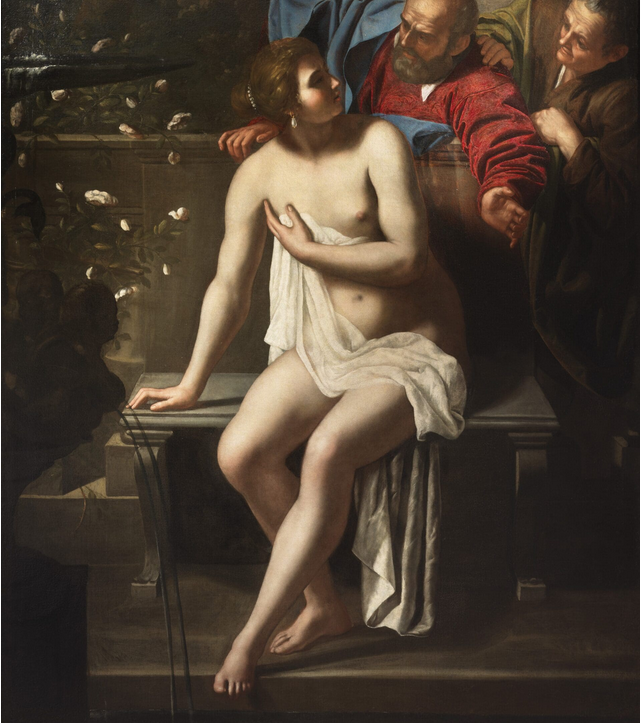The Nivaagaard Collection has acquired the Painting Susanna and the Elders by Artemisia Gentileschi

The Nivaagaard Collection has, as the first museum in Denmark, acquired a major work by a truly outstanding woman artist of the seventeenth century: the Italian Baroque painter Artemisia Gentileschi (1593 – c. 1656).
Created by Artemisia Gentileschi between 1644 and 1648, the newly acquired painting depicts the story of Susanna and the Elders, a central and recurring subject in the artist’s oeuvre. Susanna is the theme both of the earliest known work from Artemisia’s hand – painted when she was only seventeen years old, demonstrating her exceptional talent – and of her last known painting before her death. The Nivaagaard painting is a highly interesting version from her later period.
Trained as a painter in her father’s studio, Artemisia Gentileschi was one of the very few women painters in early art history to make a living as a recognised and independent professional artist. This in spite of dramatic life in which, as a very young woman, she was raped and later tortured during the subsequent trial in order to prove the truthfulness of her testimony. Through her striking and technically highly accomplished works, which represent a unique perspective on powerful female figures, she has achieved iconic status.
The Nivaagaard Collection was already fortunate enough to own a masterpiece by another major female pioneer in art history, Sofonisba Anguissola (1532–1635). The acquisition of Artemisia Gentileschi’s painting forms the best possible counterpart to this work, asserting itself as the museum’s most important acquisition since Johannes Hage donated his collection to Nivaagaard in 1908.
Artemisia Gentileschi grew up in Rome, where she was trained as a painter by her father, the acclaimed artist Orazio Gentileschi, and became one of the first women to be admitted to the prestigious Accademia delle Arti del Disegno in Florence. She initially developed a style inspired by Caravaggio’s realism and dramatic use of light, but soon found her own artistic voice and favourite subject matter. She achieved significant recognition in her own time, including through the sale of works to the Medici family in Florence and to King Charles I of England.
Artemisia often addressed religious subjects, which she reinterpreted in her paintings. Inspired by biblical and mythological themes, she highlighted heroines capable of triumphing over male dominance through intelligence or cunning. Through her repeated depictions of figures such as Susanna, Judith, Mary Magdalene, Cleopatra and Lucretia, she portrayed female characters as protagonists endowed with agency, dignity and strength. This approach has earned Artemisia a central position in art history.
Artemisia’s subjects represent a unique perspective on women in seventeenth-century art, and she brought new power to the female nude in Baroque painting. Like Caravaggio, she painted directly from live models, using no preparatory sketches. A technically accomplished painter, she mastered the artistic technique of using strong contrasts of light and shadow to create depth, dynamic compositions and drama in her paintings.
The story of Susanna is the subject to which Artemisia Gentileschi most often returned throughout her life, and the central role played by this theme in her oeuvre has often been interpreted in light of parallels to her own life, particularly her experience of rape and the subsequent violent trial.
Susanna is the subject of the earliest known work from Artemisia’s hand, painted in 1610, and of her last known work before her death, painted c. 1652. She created at least five other versions. Thus, Artemisia’s development as a painter can be clearly traced through her treatment of this particular subject. In the version of Susanna and the Elders from c. 1644–48 now acquired by The Nivaagaard Collection, a particularly distinctive artistic choice comes to the fore.
Among the various versions of the theme, several of which have achieved iconic status, this painting stands out. The other versions show Susanna turning away – recoiling from the elders, or with her hands raised in a theatrical gesture. In contrast, in this version Susanna is placed at the centre of the picture plane, her almost naked upper body caught between the hands of one of the elders. Yet, she does not lean away to the same degree as in the other depictions. Instead, she looks directly back at her attackers with a firm expression of resistance and rejection, which Artemisia Gentileschi uses to lead us into the psychological struggle taking place before us. The life-size figures (the painting measures two metres in height) make it almost frighteningly easy for the viewer to identify with Susanna’s vulnerable position. The tension in the image is palpable and intense, but the dual aspects of vulnerability and strength are elegantly balanced.
Main Image: Artemisia Gentileschi, Susanna and the Elders (1644-48). Oil on canvas, 200 x 150 cm. Photo courtesy of Nicholas Hall Gallery.
